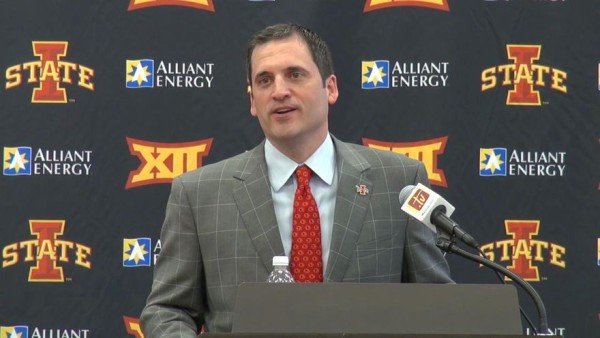Is Iowa State’s Defensive Improvement Sustainable?
Posted by Chris Stone on December 11th, 2015Last week I wrote about Oklahoma’s defensive transformation powering its rise up the college basketball rankings. This week, we may be seeing something similar happening in Ames, as Iowa State now ranks 21st in adjusted defensive efficiency after the Cyclones ranked 71st in the statistic a season ago. While the team has clearly improved on the defensive end under new head coach Steve Prohm, its performance in last night’s 83-82 win over Iowa begged the question on whether the defense has really turned the corner. The Cyclones this season continue to limit free throw attempts and shots at the rim (and did so again versus Iowa on Thursday), so what’s made them better?

Steve Prohm brought an emphasis on defense to Iowa State. Will it work?
Coming into the year, Prohm’s stated goal was to improve the defense in three key areas: transition, defensive rebounding, and three-point defense. “It starts with transition defense,” Prohm told the Ames Tribune back in October. Taking away easy baskets is a great way to make your defense better, and the Cyclones have had a bit more success in that area this season. While opponents are still attempting nearly the same percentage of their shots in transition, they are shooting about five percent worse on those attempts, according to hoop-math.com. The Cyclones have also found success keeping opponents’ off the offensive glass. Iowa State ranks 22nd nationally in defensive rebounding percentage, up from 106th last season. Opponents are snagging about six percent fewer misses this season. While Prohm has emphasized the role his guards can play in defensive rebounding, it’s actually been Jameel McKay (19.2 percent to 22.3 percent) and Georges Niang (15.2 to 17.1) who have seen their defensive rebounding percentages rise. Finally, Prohm wants his team to play an aggressive defensive style that includes running teams off the three-point line, but so far the ‘Clones have failed to do that. Teams are attempting 37.8 percent of their shots from behind the arc against Iowa State, up from 34.3 percent last season. That hasn’t come back to hurt them, though, because opponents are shooting just 29.3 percent from deep against Iowa State in 2015-16.
Improvement in those three areas seems like a recipe for success, but the problem is that the improvement may not hold. While the Cyclones held Iowa to only two fast break points, they are a mere six made shots away from giving up an effective field goal percentage in transition similar to their 2014-15 rate. Over 97 attempts in 2015-16, it’s pretty easy to chalk that improvement up to variance. The other two improvements–defensive rebounding and three-point defense–come in areas where the defense has little control over the offense’s success. According to studies done by Ken Pomeroy over the summer, we know that the offense is responsible for about 73 percent of the variance in offensive rebounding and over 80 percent of their own three-point percentage.
What that means is that Iowa State’s defensive improvements have largely come in areas where historically the defensive team doesn’t have much control. It’s worth mentioning that the Cyclones led the Big 12 in defensive rebounding during conference play last season, and they may be a special case when it comes to controlling their own destiny on the defensive glass. That trend will be tested once again in league play by teams like Baylor and West Virginia who are two of the top three teams in the country in offensive rebounding. Additionally, the three-point defense will get a work out against Kansas and Oklahoma. While Iowa State was able to pull out a win over their intrastate rival, the Hawkeyes, who rebounded 33 percent of their misses and made 41 percent of their three-point attempts, may have exposed some holes in Prohm’s new and improved defense. Whether or not this game was an outlier may turn out to be the key to the Cyclones’ success this season.









































